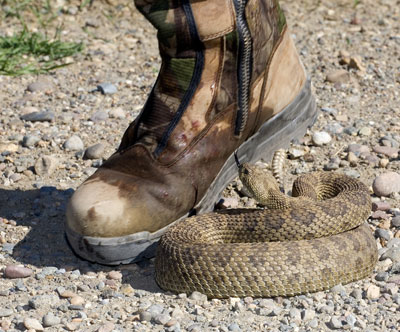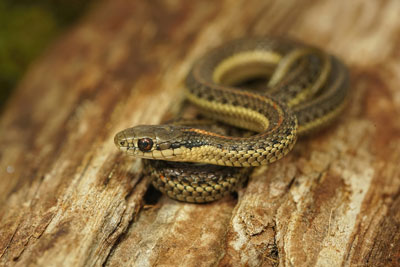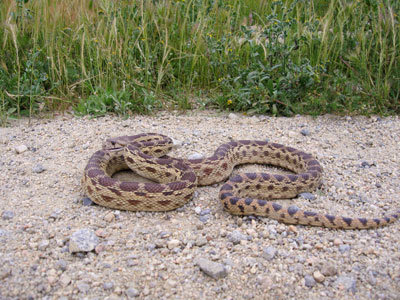




Snakes are probably the most misunderstood and feared animals in the world. Most people encounter snakes in their yards and gardens, but snakes will occasionally enter buildings in search of food. Snakes do not cause damage to buildings or other property, they do not eat any human-cultivated plant or crop foods, and they do not transmit any disease to humans. Of the 10 species of snakes found in Montana only the western rattlesnake is poisonous.
Snakes play an important role in reducing rodent and invertebrate pests. Since non-poisonous snakes are completely harmless and very beneficial, control programs for them are not necessary. Learn to distinguish between poisonous and non-poisonous snakes. Signs of snakes include shed skins, droppings, crawl markings in loose soil, and visual observations.
If you have a problem with snakes, the best advice is to just leave them alone. Considering that snakes eat mice, rats, insects, and other pests. They are a free source of rodent control for your home or property. Snakes are an important part of our local ecosystem, and we should respect all wildlife and give them their space.
Snakes are cold-blooded reptiles. They do not produce their own internal heat and must regulate their body temperatures by absorbing or giving off heat. Accordingly, they rely on the sun or resting on heated surfaces to raise their body temperatures. Conversely, they must take cover in cooler places in order to lower their body temperatures. Consequently, snakes must also have access to cover. Snakes feed mostly on animal foods such as insects, worms, eggs, and small birds or mammals. Most snakes prefer cool, dark places where food is abundant.
If you find a snake in your house, remain calm and try not to disturb the snake, which will only drive it into hiding. To remove the snake, place piles of damp burlap bags, rags, or towels in areas where the snake has been seen. After the snake has been attracted, remove the bags and snake from the building. Sometimes it is possible to place an empty bucket, box, or wastebasket slowly over a coiled snake. You may even be able to confine it to a corner with boards or other barriers. Trained professionals should remove poisonous snakes. Glue boards, such as those used for mice or rats, can also be used to capture snakes. For larger snakes, several glue boards can be placed on a larger piece of plywood or cardboard. A piece about 24"x16" would contain most large snakes in Montana. Once caught, the snake and board can be taken outside. The snake can be released unharmed by pouring vegetable oil on it (the oil counteracts the adhesive).
There are a number of home remedies for repelling snakes. Some may work, but none have been scientifically tested to prove their effectiveness. The only EPA-approved, commercially marketed chemical repellent for snakes is called "Snake-A-Way." When used and applied as directed, it is safe for humans, animals, and plant life.
Exclusion, in most cases, is the most effective method in controlling snakes. Snakes need food and cover, and unfortunately this may lead them into your house or other buildings. Too keep snakes out, start by checking for openings of ¼-inch or larger all around the foundation and base of the house. Any cracks or holes must be sealed with mortar, metal, wire, or wood. Also check and seal cracks around windows, doors, and where pipes and wires enter the structures. Another access point can be open septic or sump pump drains. A 3-inch layer of pea-size gravel around the foundation will help plug small holes.
Making your yard less desirable can make it less attractive to snakes. Controlling insect and rodent populations in the area also will help to discourage snakes by eliminating their food supply. Modify areas that provide cool, damp, dark habitat for snakes. Areas that provide shelter for rodents and cover for snakes should be eliminated, such as removing lumber, woodpiles, bushes, shrubs, rocks, boards, and other debris lying close to the ground, especially around buildings. Vegetation should be kept short around the buildings. Mowed lawns and short cropped fields near the house are less attractive to snakes and the rodents they feed on.
